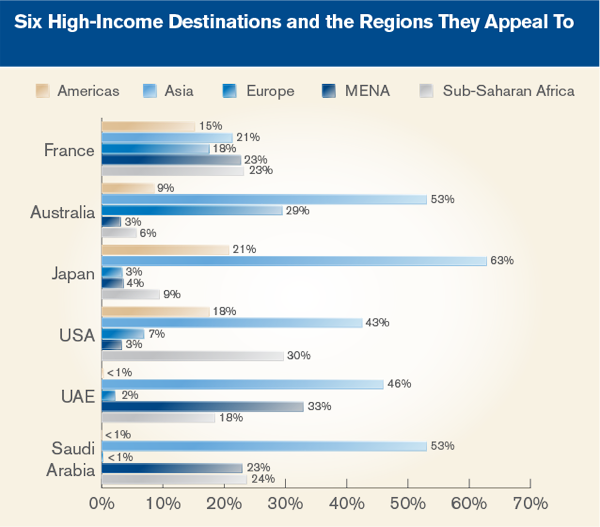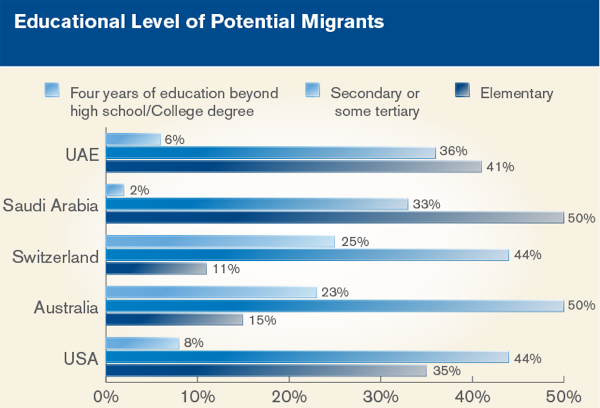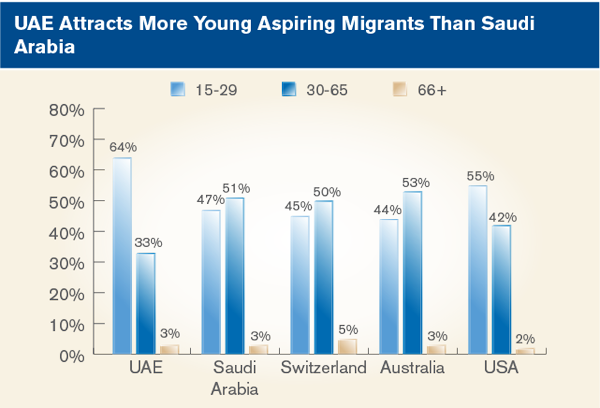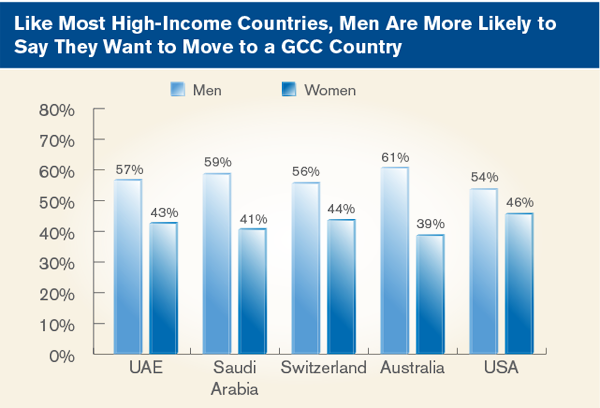With their high-income economies, the countries of the Gulf Cooperation Council (GCC) attract migrants from all over the world. As GCC countries continue to grow rapidly, potential migrants worldwide are becoming more aware of countries such as the United Arab Emirates (UAE) and Saudi Arabia as possible destinations to seek economic opportunities and employment.
This brief examines the characteristics of those interested in moving permanently to one of the six countries of the GCC[1]. It specifically focuses on potential migrants to the two most desired destinations in the GCC, according to thousands of respondents Gallup polled around the world: the UAE and Saudi Arabia. While comparing potential migrants to those two GCC countries, this brief also compares their characteristics with those of potential migrants to other high-income countries in Asia, North America, and Europe.
More potential migrants from Asia choose Saudi Arabia over the UAE
While Saudi Arabia and the UAE share a common need for migrant labor, potential migrants to GCC countries are most likely to want to move to Saudi Arabia. Fifty-two percent list Saudi Arabia as their top desired destination. The UAE is the second most desired destination, cited by 35% of potential migrants to the GCC.
Fifty-three percent of those who say they would like to move permanently to Saudi Arabia are from Asia, 24% are from sub-Saharan Africa, and 23% are from the Middle East and North Africa (MENA) region. The South Asian country of Bangladesh accounts for 32% of all people who would like to move to Saudi Arabia. After Bangladeshis, Egyptians (14%), Nigerians (14%), and Pakistanis (11%) are the nationalities most interested in migrating to Saudi Arabia. Notably, Europeans represent less than 1% of all potential migrants to Saudi Arabia.
Compared with Saudi Arabia, the UAE has fewer potential migrants in Asia (46%) and sub-Saharan Africa (18%) but more in MENA (33%) and slightly more in Europe (2%). Indians show a particular interest in the UAE, representing 26% of all people who would like to move there permanently, as do Egyptians and Pakistanis, who represent 13% and 9%, respectively, of potential migrants to the UAE.

The countries of origin of potential migrants interested in moving permanently to Saudi Arabia and the UAE are strikingly different from the home nations of those wishing to move to other high-income countries worldwide. Those wishing to migrate to either of these countries are more likely to be from Asia and MENA, while those who want to move to other high-income countries are more likely to be from other parts of the world. For instance, while Europeans account for very few of the people who tell Gallup they want to migrate to Saudi Arabia or the UAE, they represent 29% of those who would like to move to Australia and 18% of those who would like to move to France. This does not negate that European expats have played important roles in the development of Gulf economies. One example is Edward Dolman, former chairman of the auction house Christie's, who was recently chosen to serve as executive director of the Qatar Museums Authority.
Likewise, it is rare for a potential migrant from the Americas to cite a GCC country as a preferred destination. For example, less than 1% of those who say they would like to migrate to Saudi Arabia or the UAE come from this region. By contrast, larger percentages of those who would like to migrate to Japan (21%) and to the U.S. (18%) come from the Americas.

The UAE and Saudi Arabia attract relatively less educated potential migrants
The data clearly highlight that a small portion of those who want to migrate to the GCC are highly educated or have extensive training. Among those wishing to migrate to Saudi Arabia, 2% have completed four years of education beyond high school and/or have received a college degree and 33% have a secondary or some tertiary education; another 50% have completed elementary school or less. Among those who would like to move to the UAE, 6% have completed four years of education beyond high school and/or have a college degree, 36% have completed secondary or some tertiary education, and 41% have an elementary school education.
Among other high-income countries, several appeal more exclusively to highly educated potential migrants. One-quarter of those who say they would like to move to Switzerland, and roughly the same percentage of those who say they would like to migrate to Australia, have four years of education beyond high school and/or a college degree. So do 17% of people who say they are interested in migrating to Canada. These countries are among the world's richest (Switzerland's per capita income is fourth-highest among all countries; Australia's is seventh), have cities that consistently rank near the top for quality of living (Zurich and Geneva, both in Switzerland, ranked second and third in 2010; Vancouver, Canada, ranked fourth; Sydney, Australia, ranked tenth), and have liberal policies for naturalizing citizens (Canada and Australia in particular). It is easy to see why well-educated foreigners are drawn to these countries.
Interestingly, the percentage of college-educated people who say they want to migrate to the U.S. - the world's most desired destination for potential migrants - is far lower. The educational background of potential migrants to the U.S. (44% have a secondary or some tertiary education and 8% have four years of education beyond high school or a college degree) is closer to the UAE's profile than it is to Switzerland's or Australia's. However, in absolute numbers, the U.S. remains by far the preferred destination of potential migrants with a college education. Its substantial appeal to less educated potential migrants may be a function of the diversity of its economy, its reputation for political freedom, and the perceived benefits of U.S. citizenship.

In terms of their current occupations, 16% and 15%, respectively, of those who would like to migrate to Saudi Arabia and the UAE define themselves as "professional workers." [2] A statistically similar rate of potential migrants to the U.S. and Japan - 17% and 16% - also define themselves as professional workers. Australia and Switzerland, in keeping with the higher education levels of their aspiring migrant stocks, have higher percentages of professional workers wanting to migrate to them (30% and 27%, respectively).
Ages and genders of those wishing to migrate to the GCC
Potential migrants to the UAE trend younger when compared with those who want to move to Saudi Arabia as well as some high-income countries of the West. Sixty-four percent of aspiring migrants to the UAE are between the ages of 15 and 29. Compared with Saudi Arabia in particular, the UAE has a liberal social environment that may attract young potential migrants who have grown up in cosmopolitan environments elsewhere. To others - for instance, those living in rural Bangladesh or small villages in Pakistan - Saudi Arabia's social conservatism may not be an issue.

Men make up a larger percentage of potential migrants to the GCC than women. However, it is not clear that this disparity is related to negative perceptions of the GCC as a place for women.[3] The gender breakdown of those who would like to migrate to Saudi Arabia (59% men vs. 41% women) and the UAE (57% men vs. 43% women) is not much different than the percentages for potential migrants to Switzerland and the U.S. and is less lopsided than the breakdown for Australia.

As some MENA countries transition, the desire to migrate may wane
Political shifts in the region - including regime changes in Egypt and Tunisia - could have far-reaching effects on the labor pool available to GCC economies. If economies in MENA countries undergoing democratic transitions stabilize and produce more jobs, the GCC may not be able to continue to count on a steady stream of skilled Arabic-speaking migrant workers. Many who would typically be interested in a job overseas may find more convenient employment opportunities within their own countries. Currently, MENA country respondents make up 33% of all those interested in migrating to the UAE and 23% of all those interested in migrating to Saudi Arabia. It is important to note that MENA migrants have traditionally filled key positions in GCC countries in fields such as media, the judicial system, law enforcement, and higher education. A significant decline in the coming years in the number of potential migrants from MENA countries could have a disproportionate effect on the GCC.
Adults who live in MENA and who desire to move to another country permanently (25%) are more likely to plan to start a business than those who don't want to move (15%). Twenty-seven percent of potential migrants in MENA who would like to move to a GCC country plan to start a business. Thus, in addition to serving as a crucial skill link in employment chains throughout GCC countries, potential MENA migrants also have aspirations of starting their own businesses. Such a passion, if enabled, would likely result in organic and sustainable job creation opportunities crucial for many GCC economies.
In fact, many initiatives based in GCC countries have embraced enabling local entrepreneurship as a strategic investment for job creation and sourcing future markets. Last year, the UAE hosted a series of high-profile forums, including the Celebration of Entrepreneurship (COE), focused on young people's entrepreneurial successes in the MENA region. Among the initiatives launched at COE was "Wamda," a Web portal created by a private equity firm in Dubai, with the goal of helping new entrepreneurs market and grow their budding businesses. Other countries such as Qatar and Saudi Arabia have also launched efforts at studying or enabling local entrepreneurs to succeed in their businesses with the hopes that such successes will result in organic job growth for their economies.
Future implications
By gaining insight into those worldwide who wish to migrate to a GCC country, leaders can more effectively manage their brand and policies to ensure that they are attracting the type of talent their local economies need. While studying those living as expats in these countries is important, understanding those who wish to join the economies of some GCC countries is more helpful in planning for future needs.
Furthermore, the current wave of political changes taking place in some MENA countries may, in coming years, affect the ability of GCC countries to continue to bank on a large supply of Arabic-speaking skilled workers. In many GCC economies, such workers play important roles in educational, legal, and social service sectors. A Gallup survey conducted after the overthrow of former Egyptian President Hosni Mubarak hints at this possibility - 88% of Egyptians said they intended to remain in the country permanently, versus 75% who said the same when Mubarak was still in office[4].
In the past, policymakers in the GCC have worked to strike a balance. That is, how to continue to fulfill nationals' expectations of having employment opportunities available when they need them while meeting their economies' needs for highly educated, highly skilled expatriate workers. As they strive to strike this important balance, leaders must ensure that meritocracy - and not national identity - is the most important qualification employers take into account when making an employment decision. If not, many highly skilled workers will seek more merit-based environments, businesses, and economies in which to invest their skills and talents.
Survey methods
Gallup is entirely responsible for the management, design, and control of this study. For the past 70 years, Gallup has been committed to the principle that accurately collecting and disseminating the opinions and aspirations of people around the world is vital to understanding our world. Gallup's mission is to provide information in an objective, reliable, and scientifically grounded manner. Gallup is not associated with any political orientation, party, or advocacy group and does not accept partisan entities as clients.
Results are based on telephone and face-to-face interviews with 347,713 adults across multiple administrations of surveys in 148 countries between 2007 and 2009. Results among adults who would like to move to another country are based on a total sample of 75,125. The 148 countries represent more than 95% of the world's adult population. Gallup's use of standardized question wording and survey methods enables the data to be reliably compared across countries and regions.
For most countries, aggregated sample sizes (across three years of surveys) range between 1,000 and 3,000 interviews. One can say with 95% confidence that the margin of sampling error, accounting for weighting and sample design, is 0.5% for the sample of adults who would like to migrate and ranges from ±2 percentage points to ±2.5 percentage points within regions. Results are projected to the total population of each country, aged 15 and older, using 2008 World Bank population estimates.
Abu Dhabi Gallup Center
The Abu Dhabi Gallup Center is a Gallup research hub based in the capital of the United Arab Emirates. It is the product of a partnership between Gallup, the world's leading public opinion research firm, and the Crown Prince Court of Abu Dhabi.
Building on Gallup's seminal work in the field of Muslim studies, the Abu Dhabi Gallup Center (ADGC) offers unmatched research on the attitudes and aspirations of Muslims around the world. In addition to its worldwide scope, the ADGC focuses on the specific priorities of its regional base and presents innovative analysis and insights on the most important societal challenges facing the United Arab Emirates and the Gulf Cooperation Council (GCC).
[1] These countries include Bahrain, Kuwait, Oman, Qatar, Saudi Arabia, and United Arab Emirates. See http://www.gcc-sg.org/eng/
[2] The term "professional" was defined for respondents in the survey by offering a list of examples, some of which were: doctors, lawyers, teachers, nurses, accountants, and artists. Respondents were given nearly a dozen examples in the survey.
[3] The issue of gender equality in the GCC is complex and has changed in recent years as more women have gone for advanced education and taken jobs as professionals, managers, and business owners. However, female nationals in Saudi Arabia are less satisfied than their male counterparts with their personal freedom, according to Gallup surveys. In this, Saudi women have a more negative perception than do women in other parts of the GCC.
https://www.abudhabigallupcenter.com/147560/Progress-Tradition-Gulf-Cooperation-Council-States.aspx
[4] https://www.abudhabigallupcenter.com/147896/Egypt-Tahrir-Transition.aspx#1https://www.abudhabigallupcenter.com/147896/Egypt-Tahrir-Transition.aspx